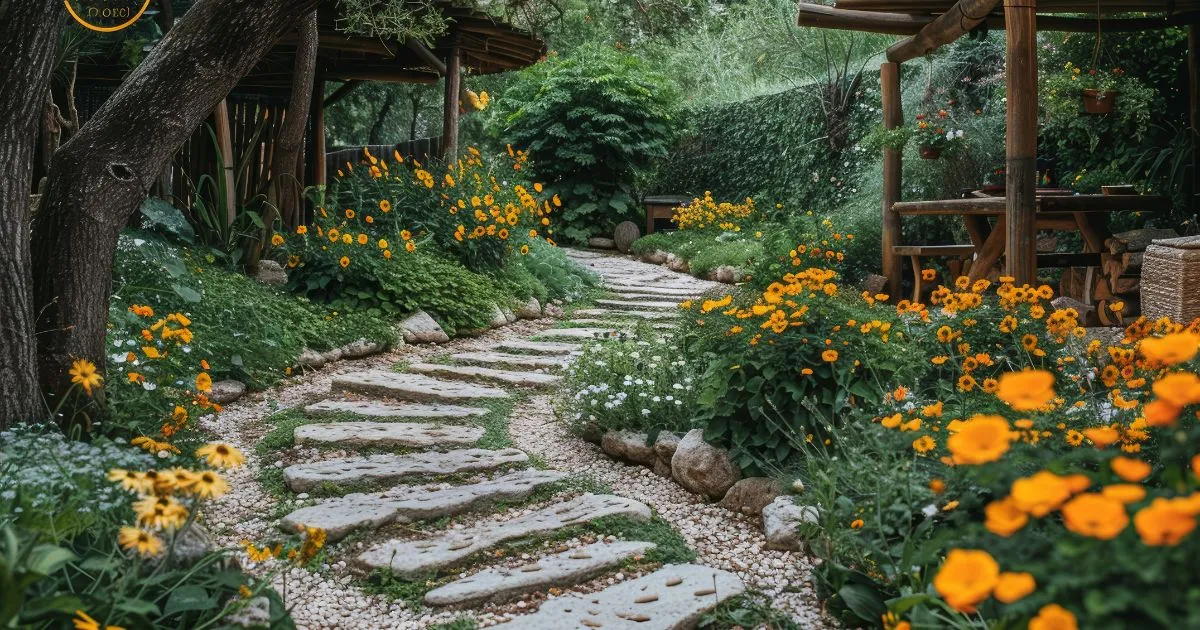Table of Contents
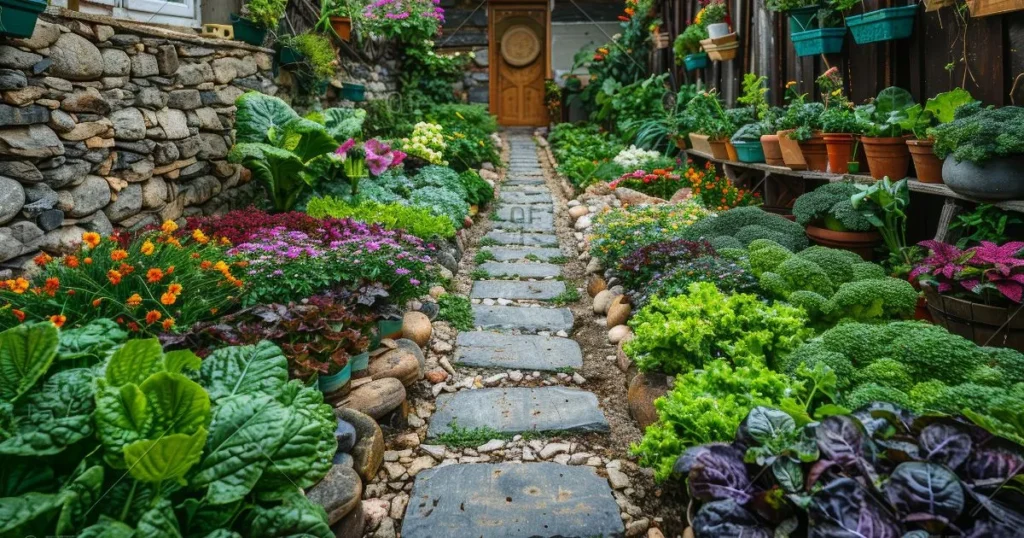
Introduction
Permaculture gardening is a sustainable approach to land management and agriculture that mimics the patterns and relationships found in natural ecosystems. The term “permaculture” is a portmanteau of “permanent agriculture” and “permanent culture,” reflecting its dual focus on sustainable farming and community living. This method of gardening is not just about growing food; it’s about creating a self-sustaining ecosystem that benefits both the environment and the people who tend it.
In a permaculture garden, every element is designed to work in harmony with the others. This means that plants, animals, and even the garden’s layout are chosen and arranged to support each other, reducing the need for external inputs like fertilizers and pesticides. The result is a garden that is not only productive but also resilient, diverse, and ecologically sound.
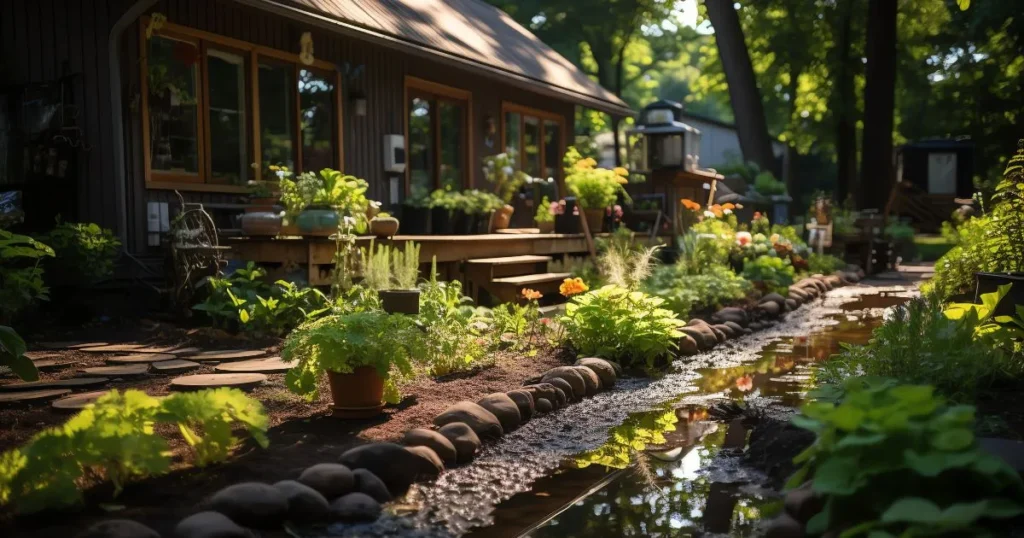
The Principles of Permaculture Gardening
1. Observe and Interact
The first principle of permaculture gardening is to observe and interact with the natural environment. This means taking the time to understand the local climate, soil conditions, and existing plant and animal life before making any changes. By observing how nature operates, you can design a garden that works with, rather than against, the natural ecosystem.
2. Catch and Store Energy
In a permaculture garden, the goal is to capture and store energy in various forms, such as sunlight, water, and organic matter. This can be achieved through techniques like rainwater harvesting, composting, and the use of solar panels. By storing energy, you can ensure that your garden remains productive even during periods of scarcity.
3. Obtain a Yield
A permaculture garden should be productive, providing a yield of food, medicine, or other resources. This principle emphasizes the importance of designing a garden that meets your needs while also benefiting the environment. The yield can be in the form of fruits, vegetables, herbs, or even flowers for pollinators.
4. Apply Self-Regulation and Accept Feedback
Permaculture gardening requires a willingness to adapt and change based on feedback from the environment. This means being open to adjusting your garden design or practices if something isn’t working. Self-regulation also involves taking responsibility for the impact of your garden on the surrounding ecosystem.
5. Use and Value Renewable Resources and Services
In a permaculture garden, renewable resources like sunlight, wind, and water are prioritized over non-renewable ones. This principle also encourages the use of natural processes, such as composting and mulching, to maintain soil health and fertility.
6. Produce No Waste
The concept of “waste” is redefined in permaculture gardening. Instead of discarding organic matter, it is recycled back into the garden through composting or mulching. This not only reduces waste but also enriches the soil, creating a closed-loop system where nothing is wasted.
7. Design from Patterns to Details
Permaculture gardening starts with understanding the broader patterns of nature, such as the water cycle or the behavior of pollinators, and then designing the garden’s details to align with these patterns. This approach ensures that the garden is both functional and harmonious with the natural world.
8. Integrate Rather Than Segregate
In a permaculture garden, different elements are integrated to create a cohesive system. For example, plants that benefit each other are grown together, and animals are incorporated into the garden to help with pest control and soil fertility. This integration creates a more resilient and productive ecosystem.
9. Use Small and Slow Solutions
Permaculture gardening favors small-scale, gradual changes over large, rapid ones. This approach allows for more careful observation and adjustment, reducing the risk of unintended consequences. Small and slow solutions are also more sustainable and easier to manage over the long term.
10. Use and Value Diversity
Diversity is a key principle in permaculture gardening. A diverse garden is more resilient to pests, diseases, and changing environmental conditions. This includes diversity in plant species, as well as in the types of animals and microorganisms that inhabit the garden.
11. Use Edges and Value the Marginal
In nature, the edges between different ecosystems are often the most productive areas. In a permaculture garden, these edges are utilized to maximize productivity. For example, the edge between a pond and a garden bed can be planted with water-loving plants that thrive in both environments.
12. Creatively Use and Respond to Change
Change is inevitable in any garden, and permaculture gardening embraces this reality. By creatively responding to changes in the environment, such as shifts in weather patterns or the introduction of new species, you can adapt your garden to remain productive and sustainable.
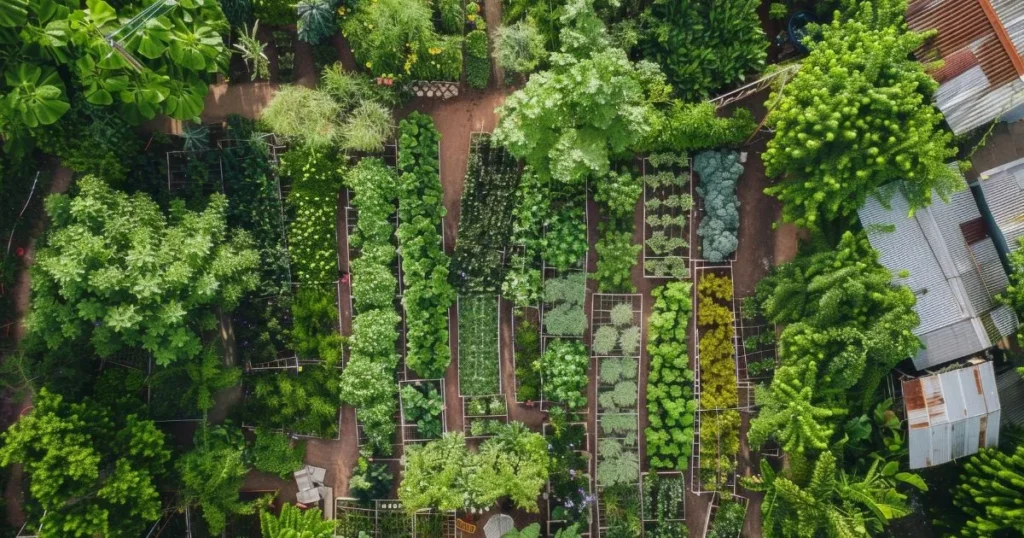
Designing a Permaculture Garden
Assessing Your Site
Before you start designing your permaculture garden, it’s important to assess your site. This involves observing the natural features of your land, such as the slope, soil type, and existing vegetation. You should also consider the local climate, including rainfall patterns and temperature fluctuations.
Zoning Your Garden
One of the key concepts in permaculture garden design is zoning. Zoning involves organizing your garden into different areas based on how frequently you need to access them and the level of care they require. For example:
- Zone 1: This is the area closest to your home and includes plants and elements that require frequent attention, such as herbs, vegetables, and compost bins.
- Zone 2: This area is slightly further from the house and includes plants that require less frequent care, such as fruit trees and perennial vegetables.
- Zone 3: This zone is for crops that require even less maintenance, such as grains and forage crops for animals.
- Zone 4: This area is for semi-wild plants and animals, such as timber trees and wild edibles.
- Zone 5: This is the wild area of your garden, left mostly untouched to allow nature to take its course.
Creating Guilds
In a permaculture garden, plants are often grouped together in guilds. A guild is a group of plants that support each other through mutual benefits, such as nutrient sharing, pest control, and shade regulation. For example, a classic guild might include a fruit tree, nitrogen-fixing plants, ground cover, and plants that attract beneficial insects.
Building Soil Health
Healthy soil is the foundation of a successful permaculture garden. Techniques for building soil health include:
- Composting: Recycling organic matter into nutrient-rich compost.
- Mulching: Covering the soil with organic material to retain moisture and suppress weeds.
- Cover Cropping: Planting crops that improve soil fertility and structure, such as legumes.
- No-Till Gardening: Minimizing soil disturbance to preserve soil structure and microorganisms.
Water Management
Water is a precious resource in any garden, and permaculture gardening emphasizes efficient water use. Techniques for water management include:
- Rainwater Harvesting: Collecting and storing rainwater for irrigation.
- Swales: Digging shallow ditches along contour lines to capture and direct water.
- Drip Irrigation: Using a system of tubes and emitters to deliver water directly to plant roots.
- Greywater Recycling: Reusing water from household activities, such as washing dishes, for irrigation.
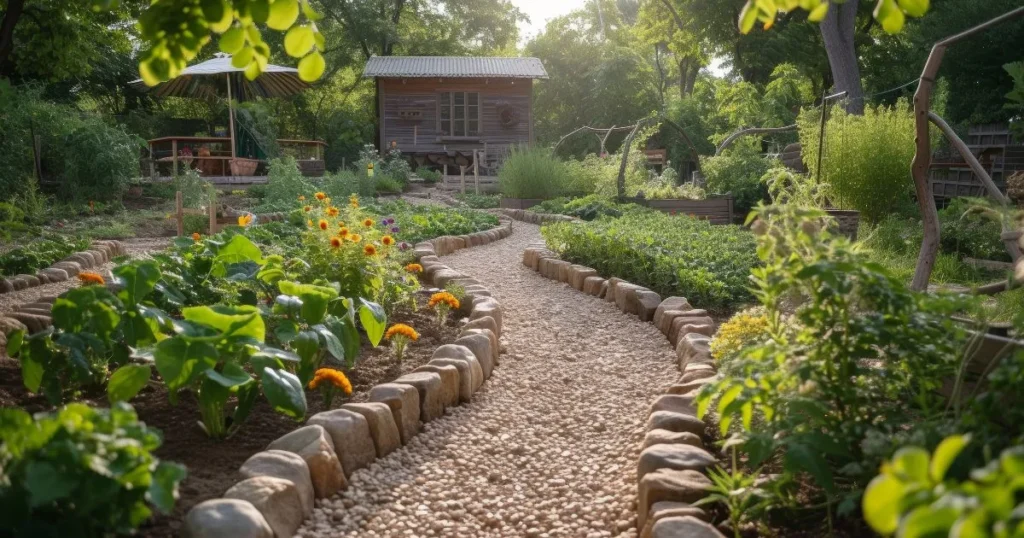
Maintaining a Permaculture Garden
Regular Observation
One of the most important aspects of maintaining a permaculture garden is regular observation. By closely monitoring your garden, you can identify potential issues early and make adjustments as needed. This might involve checking for pests, assessing soil moisture, or observing plant growth patterns.
Mulching and Composting
Mulching and composting are ongoing tasks in a permaculture garden. Mulching helps to retain soil moisture, suppress weeds, and regulate soil temperature, while composting provides a continuous source of nutrients for your plants. Both practices are essential for maintaining soil health and fertility.
Pruning and Harvesting
Pruning and harvesting are important for keeping your garden productive and healthy. Pruning helps to shape plants, encourage growth, and prevent disease, while harvesting ensures that you reap the benefits of your garden’s yield. It’s important to harvest at the right time to maximize flavor and nutritional value.
Pest and Disease Management
In a permaculture garden, pest and disease management is approached in a holistic way. Instead of relying on chemical pesticides, permaculture gardeners use natural methods to control pests and diseases. This might include introducing beneficial insects, using companion planting, or creating physical barriers.
Seasonal Adjustments
A permaculture garden is a dynamic system that changes with the seasons. As the seasons change, you may need to adjust your gardening practices to accommodate different weather conditions, plant growth cycles, and pest pressures. This might involve planting cover crops in the fall, mulching in the winter, or starting seeds indoors in the spring.
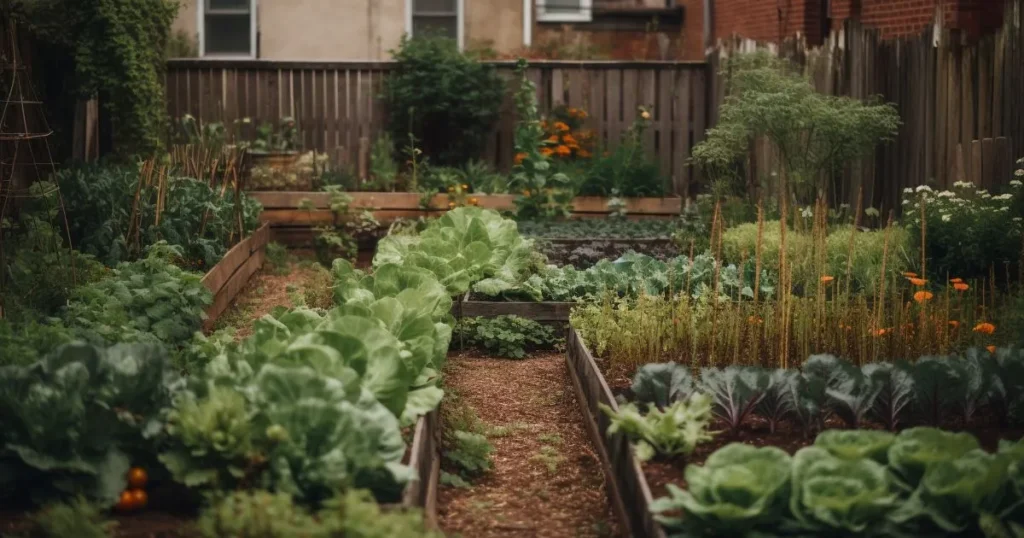
Benefits of a Permaculture Garden
Environmental Benefits
Permaculture gardens offer numerous environmental benefits, including:
- Biodiversity: By creating a diverse ecosystem, permaculture gardens support a wide range of plant and animal species.
- Soil Health: Permaculture practices like composting and mulching improve soil structure and fertility.
- Water Conservation: Efficient water management techniques reduce water waste and promote sustainable water use.
- Carbon Sequestration: Healthy soils and plants absorb and store carbon, helping to mitigate climate change.
Economic Benefits
Permaculture gardens can also provide economic benefits, such as:
- Reduced Costs: By producing your own food and resources, you can reduce your reliance on store-bought items.
- Increased Self-Sufficiency: A productive permaculture garden can provide a significant portion of your household’s food needs.
- Potential Income: Surplus produce can be sold or traded, providing an additional source of income.
Social Benefits
Permaculture gardens can have positive social impacts, including:
- Community Building: Permaculture gardens often involve community participation, fostering a sense of connection and cooperation.
- Education: Permaculture gardens can serve as educational spaces, teaching people about sustainable gardening and ecological principles.
- Health and Well-Being: Gardening has been shown to have numerous health benefits, including stress reduction and improved physical fitness.
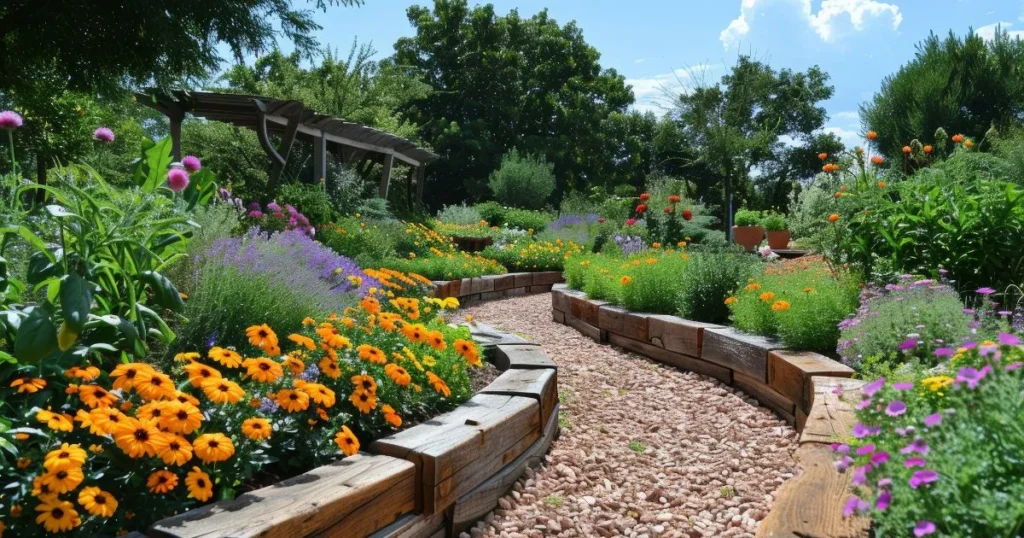
Challenges of Permaculture Gardening
Initial Setup
One of the main challenges of permaculture gardening is the initial setup. Designing and establishing a permaculture garden requires careful planning, observation, and physical labor. It can take time to see the results of your efforts, and there may be a learning curve as you adapt to new practices.
Knowledge and Skills
Permaculture gardening requires a certain level of knowledge and skills, including an understanding of ecological principles, plant biology, and soil science. While there are many resources available to help you learn, it can take time to develop the expertise needed to create and maintain a successful permaculture garden.
Time and Commitment
Maintaining a permaculture garden requires a significant time commitment. Regular observation, mulching, composting, pruning, and other tasks are essential for keeping the garden healthy and productive. While the rewards can be great, it’s important to be prepared for the ongoing effort involved.
Climate and Environmental Factors
The success of a permaculture garden can be influenced by climate and environmental factors, such as extreme weather events, soil conditions, and pest pressures. While permaculture principles are designed to create resilient systems, there may still be challenges that require adaptation and problem-solving.
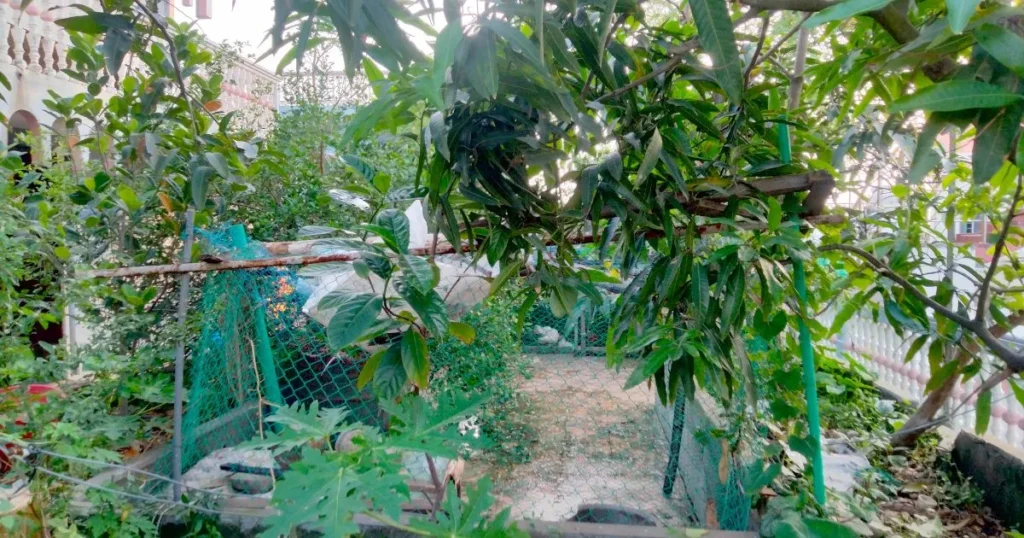
Conclusion
Permaculture gardening is a holistic and sustainable approach to gardening that offers numerous benefits for the environment, economy, and community. By mimicking natural ecosystems and applying permaculture principles, you can create a garden that is productive, resilient, and ecologically sound. While there are challenges involved, the rewards of a permaculture garden are well worth the effort. Whether you’re a seasoned gardener or a beginner, permaculture gardening offers a rewarding and sustainable way to connect with nature and produce your own food.
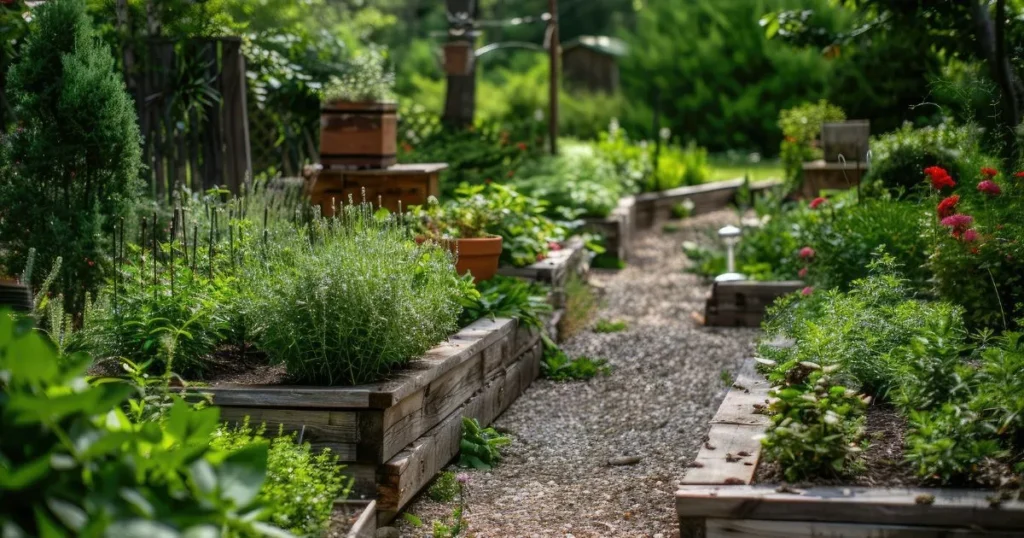
Frequently Asked Questions (FAQ)
What is a permaculture garden?
A permaculture garden is a sustainable gardening system that mimics natural ecosystems. It involves designing the garden to work in harmony with nature, using principles like diversity, integration, and renewable resources to create a self-sustaining ecosystem.
How do I start a permaculture garden?
To start a permaculture garden, begin by observing your site and understanding the local climate, soil, and existing vegetation. Then, design your garden using permaculture principles, such as zoning, guilds, and water management. Start small and gradually expand as you gain experience.
What are the key principles of permaculture gardening?
The key principles of permaculture gardening include observing and interacting with nature, catching and storing energy, obtaining a yield, applying self-regulation, using renewable resources, producing no waste, designing from patterns to details, integrating elements, using small and slow solutions, valuing diversity, using edges, and creatively responding to change.
What are the benefits of a permaculture garden?
Permaculture gardens offer numerous benefits, including environmental benefits like biodiversity and soil health, economic benefits like reduced costs and potential income, and social benefits like community building and education.
What are the challenges of permaculture gardening?
Challenges of permaculture gardening include the initial setup, the need for knowledge and skills, the time and commitment required, and the influence of climate and environmental factors. However, these challenges can be overcome with careful planning and ongoing effort.
Can I practice permaculture gardening in a small space?
Yes, permaculture gardening can be practiced in small spaces, such as urban gardens or balconies. The principles of permaculture can be adapted to fit any size of garden, and techniques like vertical gardening and container gardening can help maximize space.
How do I manage pests in a permaculture gardens ?
In a permaculture garden, pests are managed using natural methods, such as introducing beneficial insects, using companion planting, and creating physical barriers. The goal is to create a balanced ecosystem where pests are kept in check by natural predators and other factors.
What is the role of animals in a permaculture garden?
Animals can play an important role in a permaculture garden by contributing to soil fertility, pest control, and overall ecosystem health. For example, chickens can help control pests and provide manure for composting, while bees can pollinate plants and produce honey.
How do I maintain soil health in a permaculture gardens?
Soil health in a permaculture garden is maintained through practices like composting, mulching, cover cropping, and no-till gardening. These practices help to build soil fertility, improve soil structure, and support beneficial microorganisms.
Can I use permaculture principles in an existing garden?
Yes, permaculture principles can be applied to an existing garden. You can start by observing your current garden and making small changes, such as introducing companion planting, mulching, or creating a compost system. Over time, you can gradually incorporate more permaculture practices to transform your garden into a sustainable ecosystem.
How long does it take to establish a permaculture garden?
The time it takes to establish a permaculture garden can vary depending on the size of the garden, the existing conditions, and the level of effort you put in. While some elements, like annual vegetables, can produce a yield in the first year, other elements, like fruit trees, may take several years to mature. The key is to be patient and allow the garden to develop over time.
What plants are best for a permaculture garden?
The best plants for a permaculture garden are those that are well-suited to your local climate and soil conditions. Native plants, perennial vegetables, and fruit trees are often good choices. It’s also important to include a diversity of plants to create a balanced ecosystem.
How do I water a permaculture garden?
Watering a permaculture garden involves using efficient water management techniques, such as rainwater harvesting, swales, drip irrigation, and greywater recycling. The goal is to minimize water waste and ensure that plants receive the moisture they need to thrive.
Can I grow all my own food in a permaculture gardens ?
While it is possible to grow a significant portion of your own food in a permaculture garden, the amount of food you can produce will depend on the size of your garden, the types of plants you grow, and the level of effort you put in. Many permaculture gardeners aim to produce a substantial amount of their own food while also supplementing with other sources.
What is the difference between permaculture gardening and organic gardening?
While both permaculture gardening and organic gardening emphasize sustainable practices, permaculture gardening takes a more holistic approach by designing the garden to mimic natural ecosystems and integrating various elements to create a self-sustaining system. Organic gardening focuses more on avoiding synthetic chemicals and using natural inputs to grow plants.
How do I learn more about permaculture gardening?
There are many resources available to learn more about permaculture gardening, including books, online courses, workshops, and local permaculture groups. Some popular books on the subject include “Permaculture: A Designer’s Manual” by Bill Mollison and “Gaia’s Garden” by Toby Hemenway. Additionally, many permaculture organizations offer courses and certifications in permaculture design.
Can I practice permaculture gardening in a cold climate?
Yes, permaculture gardening can be practiced in cold climates. While the specific plants and techniques may vary, the principles of permaculture can be adapted to suit any climate. For example, in cold climates, you might focus on cold-hardy plants, season extension techniques, and strategies for protecting plants from frost.
What is the role of trees in a permaculture gardens ?
Trees play a crucial role in a permaculture garden by providing shade, improving soil health, and supporting biodiversity. Fruit trees, nut trees, and timber trees are often included in permaculture gardens to provide food, materials, and habitat for wildlife.
How do I design a permaculture garden for a sloped site?
Designing a permaculture garden for a sloped site involves using techniques like contour planting, swales, and terracing to manage water flow and prevent erosion. By following the natural contours of the land, you can create a garden that is both functional and sustainable.
What is the importance of diversity in a permaculture garden?
Diversity is important in a permaculture garden because it creates a more resilient and productive ecosystem. A diverse garden is better able to withstand pests, diseases, and changing environmental conditions. It also supports a wider range of plant and animal species, contributing to overall ecosystem health.
How do I incorporate animals into a permaculture garden?
Animals can be incorporated into a permaculture garden by providing them with habitat and integrating them into the garden’s design. For example, chickens can be kept in a mobile coop that is moved around the garden to provide pest control and fertilization, while bees can be kept in hives to pollinate plants and produce honey.
What is the role of compost in a permaculture garden?
Compost plays a vital role in a permaculture garden by recycling organic matter into nutrient-rich soil amendments. Composting helps to build soil fertility, improve soil structure, and support beneficial microorganisms. It also reduces waste by turning kitchen scraps and garden debris into valuable resources.
How do I create a guild in a permaculture garden?
To create a guild in a permaculture garden, select a central plant, such as a fruit tree, and surround it with companion plants that provide mutual benefits. For example, you might plant nitrogen-fixing plants, ground cover, and plants that attract beneficial insects around the central tree. The goal is to create a self-sustaining group of plants that support each other.
What is the difference between permaculture and agroforestry?
While both permaculture and agroforestry involve integrating trees and other plants into agricultural systems, permaculture is a broader design philosophy that encompasses not only agriculture but also community living and sustainable land management. Agroforestry is a specific practice that focuses on the integration of trees and shrubs into agricultural landscapes.
How do I manage weeds in a permaculture garden?
Weeds can be managed in a permaculture garden using techniques like mulching, cover cropping, and manual removal. The goal is to suppress weeds without relying on chemical herbicides, while also recognizing that some weeds can have beneficial roles in the ecosystem, such as providing ground cover or attracting beneficial insects.
What is the role of fungi in a permaculture garden?
Fungi play an important role in a permaculture garden by decomposing organic matter, improving soil structure, and forming symbiotic relationships with plants. Mycorrhizal fungi, for example, help plants absorb nutrients and water, while saprophytic fungi break down dead plant material into compost.
How do I create a water-efficient permaculture garden?
To create a water-efficient permaculture garden, use techniques like rainwater harvesting, swales, drip irrigation, and greywater recycling. Choose drought-tolerant plants and group plants with similar water needs together. Mulching and soil improvement can also help retain moisture and reduce the need for irrigation.
What is the role of insects in a permaculture garden?
Insects play a crucial role in a permaculture garden by pollinating plants, decomposing organic matter, and controlling pests. Beneficial insects, such as ladybugs and predatory wasps, can help keep pest populations in check, while pollinators like bees and butterflies are essential for fruit and seed production.
How do I create a permaculture garden in an urban environment?
Creating a permaculture garden in an urban environment involves adapting permaculture principles to fit small spaces, such as balconies, rooftops, or small yards. Techniques like vertical gardening, container gardening, and community gardening can help maximize space and create a productive urban garden.
What is the role of mulch in a permaculture garden?
Mulch plays a vital role in a permaculture garden by retaining soil moisture, suppressing weeds, regulating soil temperature, and adding organic matter to the soil. Mulching also helps to create a healthy soil ecosystem by providing habitat for beneficial microorganisms and insects.
How do I choose plants for a permaculture garden?
When choosing plants for a permaculture garden, consider factors like your local climate, soil conditions, and the specific needs of the plants. Select a diversity of plants, including native species, perennial vegetables, and fruit trees, to create a balanced and resilient ecosystem.
What is the role of perennial plants in a permaculture garden?
Perennial plants play a key role in a permaculture garden by providing long-term stability and productivity. Unlike annual plants, which need to be replanted each year, perennials continue to grow and produce for multiple years, reducing the need for annual planting and soil disturbance.
How do I create a permaculture garden on a budget?
Creating a permaculture garden on a budget involves using resources wisely and focusing on low-cost techniques. Start small, use recycled materials, and propagate plants from seeds or cuttings. Composting, mulching, and rainwater harvesting are cost-effective ways to build soil health and conserve water.
What is the role of community in permaculture gardening?
Community plays an important role in permaculture gardening by fostering collaboration, sharing resources, and creating a sense of connection. Community gardens, seed swaps, and permaculture workshops are examples of how people can come together to support sustainable gardening practices.
How do I create a permaculture garden that supports wildlife?
To create a permaculture garden that supports wildlife, include a diversity of plants that provide food, shelter, and habitat for animals. Create water sources, such as ponds or birdbaths, and avoid using chemical pesticides. Encourage beneficial insects, birds, and other wildlife by providing nesting sites and food plants.
What is the role of education in permaculture gardening?
Education is a key component of permaculture gardening, as it helps people learn about sustainable practices and ecological principles. Permaculture gardens can serve as educational spaces, teaching people about the importance of biodiversity, soil health, and water conservation.
How do I create a permaculture garden that is resilient to climate change?
To create a permaculture garden that is resilient to climate change, focus on building healthy soil, conserving water, and selecting plants that are adapted to changing conditions. Use techniques like mulching, cover cropping, and rainwater harvesting to create a garden that can withstand extreme weather events and shifting climate patterns.
What is the role of permaculture gardening in sustainable living?
Permaculture gardening plays a crucial role in sustainable living by providing a way to produce food and resources in harmony with nature. By reducing reliance on external inputs and creating self-sustaining ecosystems, permaculture gardening contributes to a more sustainable and resilient way of life.
How do I create a permaculture garden that is low-maintenance?
To create a low-maintenance permaculture garden, focus on perennial plants, mulching, and efficient water management. Design the garden to work with natural processes, such as nutrient cycling and pest control, to reduce the need for ongoing maintenance. Use techniques like no-till gardening and companion planting to create a self-sustaining system.
What is the role of permaculture gardening in food security?
Permaculture gardening contributes to food security by providing a reliable source of fresh, nutritious food. By growing a diversity of crops and using sustainable practices, permaculture gardens can help to ensure a stable food supply, even in the face of environmental challenges.
How do I create a permaculture garden that is aesthetically pleasing?
To create an aesthetically pleasing permaculture garden, consider the visual appeal of the garden’s design, including the arrangement of plants, the use of color and texture, and the integration of natural elements like water features and pathways. Balance functionality with beauty to create a garden that is both productive and visually appealing.
What is the role of permaculture gardening in reducing carbon emissions?
Permaculture gardening helps to reduce carbon emissions by sequestering carbon in the soil and plants, reducing the need for synthetic fertilizers and pesticides, and promoting sustainable land management practices. By creating healthy, carbon-rich soils, permaculture gardens contribute to climate change mitigation.
How do I create a permaculture garden that supports pollinators?
To create a permaculture garden that supports pollinators, include a diversity of flowering plants that provide nectar and pollen throughout the growing season. Avoid using chemical pesticides, and create habitat for pollinators by providing nesting sites, such as bee hotels or undisturbed soil.

